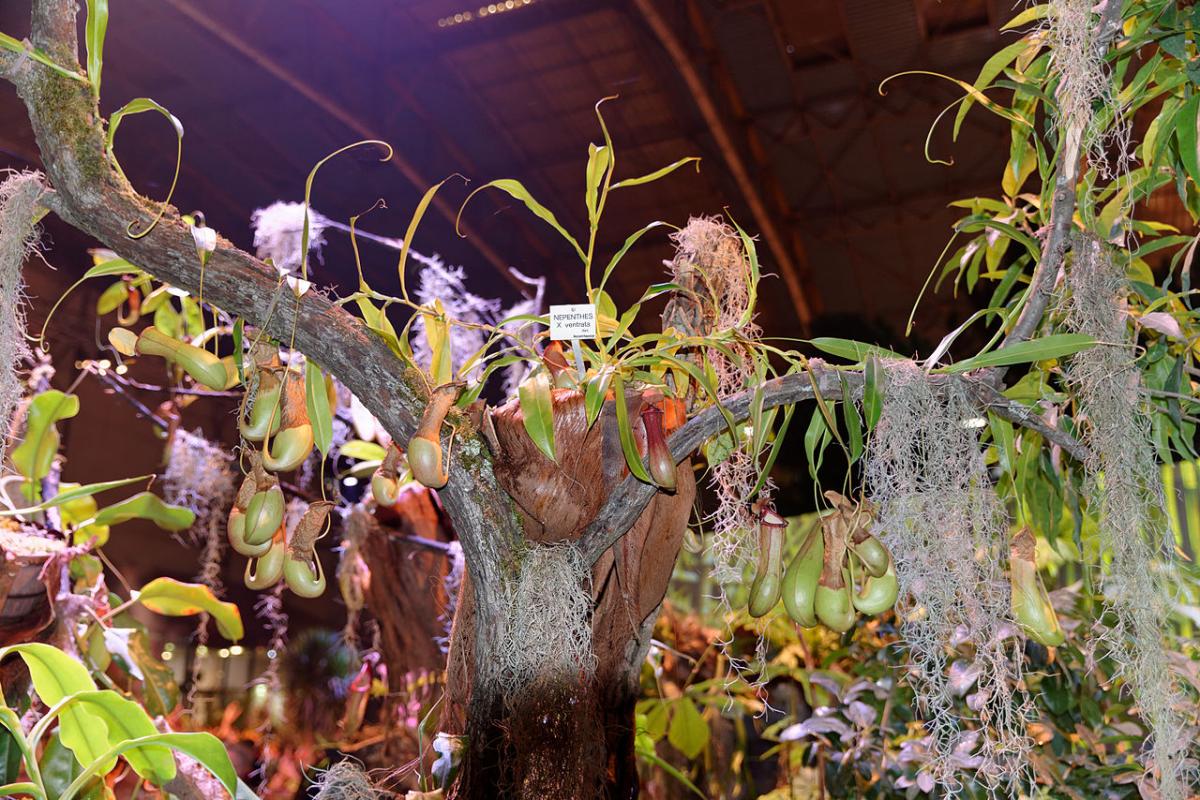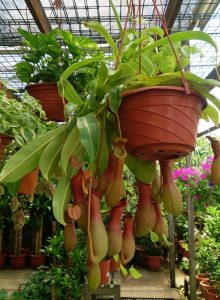La Nepenthes venrata it is a species of carnivorous plant widely commercialized in Spain. In fact, it is usually one of the first to buy when starting a collection. But it is also one of the most delicate.
As it is tropical, you have to be very careful about exposing it to low temperatures, since it does not support frost. Now this is partly interesting, since it may be a good idea to grow it at home or in a greenhouse.
Origin and characteristics of Nepenthes venrata
It is a hybrid species of carnivorous plant that grows in the Philippines. It is a natural hybrid of Nepenthes, which occurs as a result of the cross between Nepenthes alata y Nepenthes ventricosa. In nurseries it is usually one of the first to be seen, since it is kept in hanging pots so that its jugs attract attention.
These jars are yellowish-green in the lower half and reddish in the upper half., although the cultivars that have been obtained from different crosses have led to specimens with traps of other colors. The leaves are lanceolate with an easily distinguishable main vein that continues to grow out of the leaf to form the jug.
The height of the plant is about 30-35 centimeters maximum, so the pot does not have to be too big as we will now see.
What are the care of the Nepenthes venrata?

Image - Wikimedia / François de Dijon
La Nepenthes venrata It is a plant that can be easy to care for, as long as a few things are taken into account. As we said at the beginning, it is very sensitive to cold, but it is also important that a very specific type of water and substrate is used so that problems do not arise.
Location
Unlike other carnivorous plants, such as Sarracenia, the Nepenthes venrata it has to be in a bright area, but without direct sunlight. Its leaves burn quickly when it is in an exposed place, so it is necessary to ensure that it is a little protected from the star king.
If you want to keep it indoors, put it in a bright room. Also, it is important that it is away from drafts (fan, air conditioner, etc.).
Humidity
The humidity must be high, whether grown indoors or outdoors. If you live near the coast or on an island and you are going to grow it outside, you will not have to do anything as the humidity will be high in itself; But if, on the contrary, you live indoors and / or want to have it inside the house, then you will have to take measures so that your carnivorous plant does not dry out.
For example, it is highly recommended that during the summer the leaves are sprayed or sprayed 1-2 times a day with rain or distilled water. Likewise, it is interesting to put containers with water around it, especially during autumn and winter because in these seasons it is not recommended to spray the leaves due to the high risk of rotting.
Irrigation
Irrigation will be moderate; that is to say, it is necessary to water when the substrate dries a little. The frequency will vary throughout the year, so in summer it will be watered more often than in winter. But how often exactly? Well, generally about 3 times a week during the growing season (spring and summer, with minimum temperatures above 15ºC and below 35ºC). While it is at rest, it will water less.
Use rainwater or distilled water. Likewise, it is important that the pot has holes and that you avoid putting a plate under it, as it is a plant that does not support waterlogging.
Substratum
This is a plant that It must be grown in a plastic pot of about 20 centimeters in diameter with holes in its base, and filled with a substrate composed of 60% unfertilized white peat. (on sale here) and 40% perlite (on sale here). It mixes well in a bowl or other container, and is moistened with distilled or rain water before planting the Nepenthes in the pot. In this way, it will be much easier and faster to transplant it.
Transplant
Its growth rate is quite slow, so that You will only have to transplant it when you see roots coming out of the drainage holes, or every 3-4 years. Do it in spring, when the minimum temperature is at least 18ºC.
Subscriber
Carnivorous plants they do not have to be paid. They obtain the necessary nutrients from the prey they capture.
Pests
It does not usually have, but mealybugs they are a pest that can be seen in summer and, especially, if the environment is very dry. Ideally, remove them by hand or with a brush. If they reappear, treat the plant with diatomaceous earth.
Rusticity
La Nepenthes venrata resists up to 5ºC, but it is better not to drop below 10ºC.

Image - Wikimedia / Mokkie
Do you like this carnivorous plant?